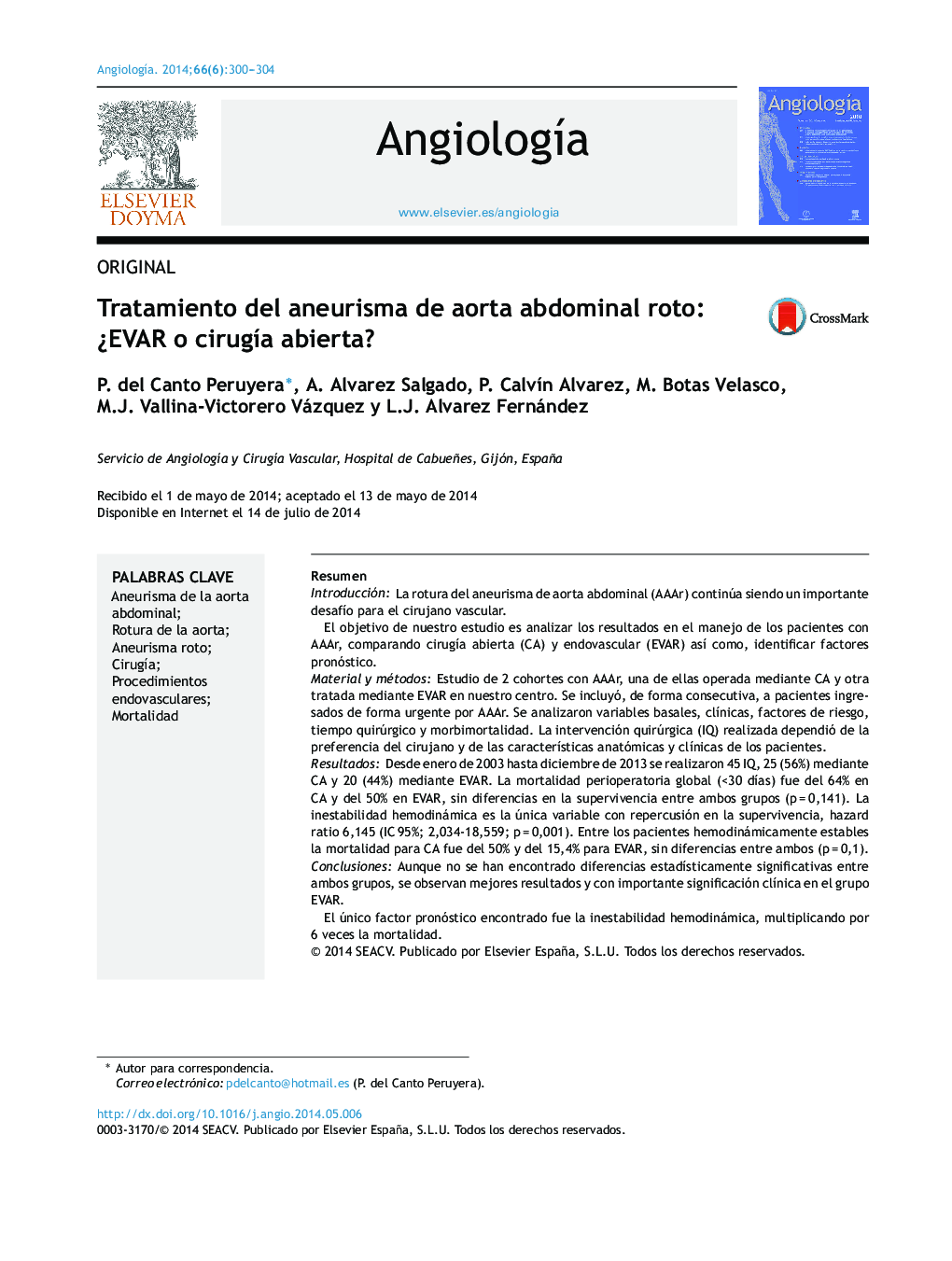| کد مقاله | کد نشریه | سال انتشار | مقاله انگلیسی | نسخه تمام متن |
|---|---|---|---|---|
| 2867504 | 1171090 | 2014 | 5 صفحه PDF | دانلود رایگان |
ResumenIntroducciónLa rotura del aneurisma de aorta abdominal (AAAr) continúa siendo un importante desafío para el cirujano vascular.El objetivo de nuestro estudio es analizar los resultados en el manejo de los pacientes con AAAr, comparando cirugía abierta (CA) y endovascular (EVAR) así como, identificar factores pronóstico.Material y métodosEstudio de 2 cohortes con AAAr, una de ellas operada mediante CA y otra tratada mediante EVAR en nuestro centro. Se incluyó, de forma consecutiva, a pacientes ingresados de forma urgente por AAAr. Se analizaron variables basales, clínicas, factores de riesgo, tiempo quirúrgico y morbimortalidad. La intervención quirúrgica (IQ) realizada dependió de la preferencia del cirujano y de las características anatómicas y clínicas de los pacientes.ResultadosDesde enero de 2003 hasta diciembre de 2013 se realizaron 45 IQ, 25 (56%) mediante CA y 20 (44%) mediante EVAR. La mortalidad perioperatoria global (<30 días) fue del 64% en CA y del 50% en EVAR, sin diferencias en la supervivencia entre ambos grupos (p = 0,141). La inestabilidad hemodinámica es la única variable con repercusión en la supervivencia, hazard ratio 6,145 (IC 95%; 2,034-18,559; p = 0,001). Entre los pacientes hemodinámicamente estables la mortalidad para CA fue del 50% y del 15,4% para EVAR, sin diferencias entre ambos (p = 0,1).ConclusionesAunque no se han encontrado diferencias estadísticamente significativas entre ambos grupos, se observan mejores resultados y con importante significación clínica en el grupo EVAR.El único factor pronóstico encontrado fue la inestabilidad hemodinámica, multiplicando por 6 veces la mortalidad.
IntroductionRupture of abdominal aortic aneurysm (rAAA) remains a major challenge for the vascular surgeon.The aim of this study is to analyze the results in the management of patients with rAAA, comparing open surgery (OS) and endovascular surgery (EVAR), as well as identifying prognostic factors.Material and methodsA study was conducted on two cohorts with rAAA, one treated with open surgery and another treated with EVAR. Patients admitted for rAAA were included consecutively. Baseline and clinical variables, risk factors, surgical time, morbidity and mortality were analyzed. Surgical intervention (SI) performed depended on surgeon preference and anatomical and clinical characteristics of the patients.ResultsA total of 45 surgical procedures were performed between January 2003 and December 2013, 25 (56%) using OS and 20 (44%) using EVAR. The overall peri-operative mortality (<30 days) was 64% in OS and 50% in EVAR, with no significant differences in survival between the two groups (P=.141). Hemodynamic instability is the only variable with an impact on survival, hazard ratio 6.145 (IC 95%, 2.034–18.559; P=.001). In hemodynamically stable patients, mortality was 50% for OS and 15.4% for EVAR; no differences were observed between the groups (P=.1).ConclusionsAlthough there were no statistically significant differences between the 2 groups, better results with an important clinical relevance were observed in the EVAR group.Hemodynamic instability was the only prognostic factor found, multiplying mortality by 6.
Journal: Angiología - Volume 66, Issue 6, November–December 2014, Pages 300–304
